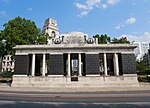Trinity House

The Corporation of Trinity House of Deptford Strond, also known as Trinity House (and formally as The Master, Wardens and Assistants of the Guild Fraternity or Brotherhood of the most glorious and undivided Trinity and of St Clement in the Parish of Deptford Strond in the County of Kent), is the official authority for lighthouses in England, Wales, the Channel Islands and Gibraltar. Trinity House is also responsible for the provision and maintenance of other navigational aids, such as lightvessels, buoys, and maritime radio/satellite communication systems. It is also an official deep sea pilotage authority, providing expert navigators for ships trading in Northern European waters. Trinity House is also a maritime charity, disbursing funds for the welfare of retired seamen, the training of young cadets and the promotion of safety at sea; for the financial year ending in March 2013 it spent approximately £6.5 million in furtherance of its charitable objectives. Funding for the work of the lighthouse service comes from "light dues" levied on commercial vessels calling at ports in the British Isles, based on the net registered tonnage of the vessel. The rate is set by the Department for Transport, and annually reviewed. Funding for the maritime charity is generated separately. The corporation was founded in 1514. Its first master was Thomas Spert (later Sir), sailing master of Henry VIII's flagship Mary Rose and of Henry Grace à Dieu.
Excerpt from the Wikipedia article Trinity House (License: CC BY-SA 3.0, Authors, Images).Trinity House
Trinity Place, London Whitechapel
Geographical coordinates (GPS) Address Nearby Places Show on map
Geographical coordinates (GPS)
| Latitude | Longitude |
|---|---|
| N 51.51 ° | E -0.077 ° |
Address
Tower Hill
Trinity Place
EC3N 4DJ London, Whitechapel
England, United Kingdom
Open on Google Maps











